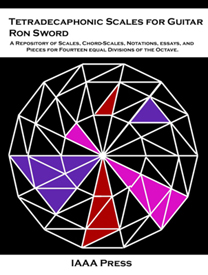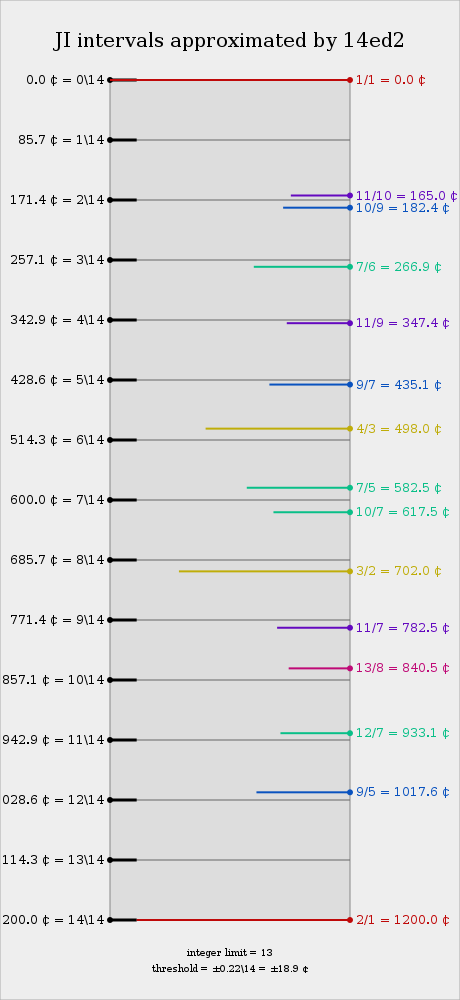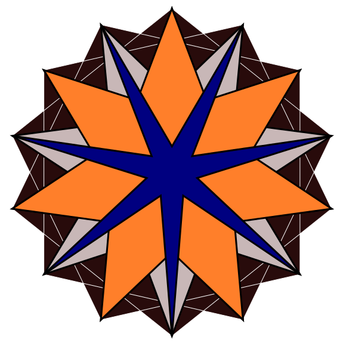14edo: Difference between revisions
→Music: rework |
|||
| Line 500: | Line 500: | ||
; [[Xotla]] | ; [[Xotla]] | ||
* [https://www.youtube.com/watch?v=pppScREtqV4 '' | * "Chiral" from ''Micro Biological'' (2019) [https://open.spotify.com/track/4JM0RCG0IbPE0ctJwuqv1a Spotify] | [https://xotla.bandcamp.com/track/chiral-14edo Bandcamp] | [https://www.youtube.com/watch?v=pppScREtqV4 YouTube] | ||
* "Fires of The Frozen Jungle" from ''Nano Particular'' (2019) [https://open.spotify.com/track/6mx3yJFBlMfjk4neWz5WeA Spotify] | [https://xotla.bandcamp.com/track/fires-of-the-frozen-jungle-14edo Bandcamp] | [https://www.youtube.com/watch?v=LLJs_ldcwd0 YouTube] | |||
* "Surprise Me" from ''Pico Metric'' (2019) [https://open.spotify.com/track/0MC2o8YFKlKBArzP8gknxS Spotify] | [https://xotla.bandcamp.com/track/surprise-me-14edo Bandcamp] | [https://www.youtube.com/watch?v=ex9eGS6QoSc YouTube] | |||
* "Orbital motive" from ''Lesser Groove'' (2020) [https://open.spotify.com/track/2ZSfVcO70Umb7vdQZffrMU Spotify] | [https://xotla.bandcamp.com/track/orbital-motive-14edo Bandcamp] | [https://www.youtube.com/watch?v=wRZ6kvlkuA4 YouTube] | |||
* "Jungle Tunnel" from ''Science Fraction'' (2022) [https://open.spotify.com/track/3i96DrKEQZ4k0HW48YZ9bj Spotify] | [https://xotla.bandcamp.com/track/jungle-tunnel-14edo Bandcamp] | [https://www.youtube.com/watch?v=Zkt0dXdattw YouTube] | |||
; Yeah Gore | ; [[Yeah Gore]] | ||
* [https://www.youtube.com/watch?v=eX7BSfECELg ''Zvezda''] (2019) | * [https://www.youtube.com/watch?v=eX7BSfECELg ''Zvezda''] (2019) | ||
* [https://www.youtube.com/watch?v=gZYCESuEknw ''14 TET 41441''] (2020) | * [https://www.youtube.com/watch?v=gZYCESuEknw ''14 TET 41441''] (2020) | ||
Revision as of 13:33, 6 October 2023
| ← 13edo | 14edo | 15edo → |
The 14 equal divisions of the octave (14edo), or the 14(-tone) equal temperament (14tet, 14et) when viewed from a regular temperament perspective, is the tuning that divides the octave into fourteen equal steps of about 86 cents. 14edo contains 7edo, doubling its number of tones.
Theory
The character of 14edo does not well serve those seeking low-limit JI approaches, with the exception of 5:7:9:11:17:19 (which is quite well approximated, relative to other JI approximations of the low-numbered EDOs). However, the ratios 7/5, 7/6, 9/7, 10/7, 10/9, 11/7, 11/9, and 11/10 are all recognizably approximated, and if you accept that 14edo offers approximations of these intervals, you end up with a low-complexity, high-damage 11-limit temperament where the commas listed at the bottom of this page are tempered out. This leads to some of the bizarre equivalences described in the second "Approximate Ratios" column in the table below.
14et has quite a bit of xenharmonic appeal, in a similar way to 17et, on account of having three types of 3rd and three types of 6th, rather than the usual two of 12et. Since 14et also has a recognizable 4th and 5th, this makes it good for those wishing to explore alternative triadic harmonies without adding significantly more notes. It possesses a triad-rich 9-note MOS scale of 5L 4s, wherein 7 of 9 notes are tonic to a subminor, supermajor, and/or neutral triad.
Prime harmonics
| Harmonic | 2 | 3 | 5 | 7 | 11 | 13 | 17 | 19 | 23 | 29 | 31 | |
|---|---|---|---|---|---|---|---|---|---|---|---|---|
| Error | Absolute (¢) | +0.0 | -16.2 | +42.3 | -26.0 | -37.0 | +16.6 | -19.2 | -40.4 | -28.3 | -1.0 | -30.7 |
| Relative (%) | +0.0 | -18.9 | +49.3 | -30.3 | -43.2 | +19.4 | -22.4 | -47.1 | -33.0 | -1.2 | -35.9 | |
| Steps (reduced) |
14 (0) |
22 (8) |
33 (5) |
39 (11) |
48 (6) |
52 (10) |
57 (1) |
59 (3) |
63 (7) |
68 (12) |
69 (13) | |
Intervals
| Steps | Cents | Approximate Harmonics |
Approximate Ratios 1 [1] |
Approximate Ratios 2 [2] |
Approximate Ratios 3 [3] |
Ups and Downs Notation | Interval Type | Audio | ||
|---|---|---|---|---|---|---|---|---|---|---|
| 0 | 0.000 | 1 | 1/1 | 1/1 | 1/1 | unison | 1 | D | Unison | |
| 1 | 85.714 | 67 | 20/19, 19/18, 18/17 | 28/27, 22/21, 21/20 | up-unison, down-2nd |
^1, v2 | ^D, vE | Narrow Minor 2nd | ||
| 2 | 171.429 | 71 | 11/10, 10/9, 19/17 | 12/11, 11/10, 10/9, 9/8 | 11/10, 10/9 | 2nd | 2 | E | Neutral 2nd | |
| 3 | 257.143 | 37 | 22/19, 20/17 | 8/7, 7/6 | 15/13, 7/6 | up-2nd, down-3rd |
^2, v3 | ^E, vF | Subminor 3rd | |
| 4 | 342.857 | 39 | 17/14, 11/9 | 6/5, 11/9, 5/4 | 11/9 | 3rd | 3 | F | Neutral 3rd | |
| 5 | 428.571 | 41 | 22/17, 14/11, 9/7 | 14/11, 9/7 | 14/11, 9/7 | up-3rd, down-4th |
^3, v4 | ^F, vG | Supermajor 3rd | |
| 6 | 514.286 | 43 | 19/14 | 4/3, 15/11, 11/8 | 4/3 | 4th | 4 | G | Wide 4th | |
| 7 | 600.000 | 91 | 7/5, 10/7 | 7/5, 10/7 | 7/5, 10/7 | up-4th, down-5th |
^4, v5 | ^G, vA | Tritone | |
| 8 | 685.714 | 95 | 28/19 | 16/11, 22/15, 3/2 | 3/2 | 5th | 5 | A | Narrow 5th | |
| 9 | 771.429 | 25 | 14/9, 11/7, 17/11 | 14/9, 11/7 | 14/9, 11/7 | up-5th, down-6th |
^5, v6 | ^A, vB | Subminor 6th | |
| 10 | 857.143 | 105 | 18/11, 28/17 | 8/5, 18/11, 5/3 | 18/11 | 6th | 6 | B | Neutral 6th | |
| 11 | 942.857 | 55 | 17/10, 19/11 | 12/7, 7/4 | 12/7, 26/15 | up-6th, down-7th |
^6, v7 | ^B, vC | Supermajor 6th | |
| 12 | 1028.571 | 29 | 19/34, 9/5, 20/11 | 16/9, 9/5, 20/11, 11/6 | 9/5, 20/11 | 7th | 7 | C | Neutral 7th | |
| 13 | 1114.286 | 61 | 17/9, 36/19, 19/10 | 40/21, 21/11, 27/14 | up-7th, down-8ve |
^7, v8 | ^C, vD | Wide Major 7th | ||
| 14 | 1200.000 | 2 | 2/1 | 2/1 | 2/1 | 8ve | 8 | D | Octave | |
Ivor Darreg wrote in this article:
The 14-tone scale presents a new situation: while one might use ordinary sharps and flats in addition to conventional naturals for the notes of the 7-tone-equal temperament, it would be misleading and confusing to do so, because there is a 7-tone circle of fifths (admittedly quite distorted) already notatable and nameable as F C G D A E B in the usual manner. But there is no 14-tone circle of fifths. There is simply a second set of 7 fifths in a circle which does not intersect the with the first set. Thus is we think of B-flat and B, or B-natural and F-sharp, the 14-tone-system interval would NOT be a fifth of that system and would not sound like one, since B F would be the very same kind of distorted fifth that C G or A E happens to be in 7 or 14. Our suggestion is to call the new notes of 14, the second set of 7, F* C* G* D* A* E* B*, and use asterisks or arrows or whatever you please on the staff. Or just number the tones as for 13.
The following chart (made by TDW) shows this recommendation as "standard notation" as well as a proposed alternative.
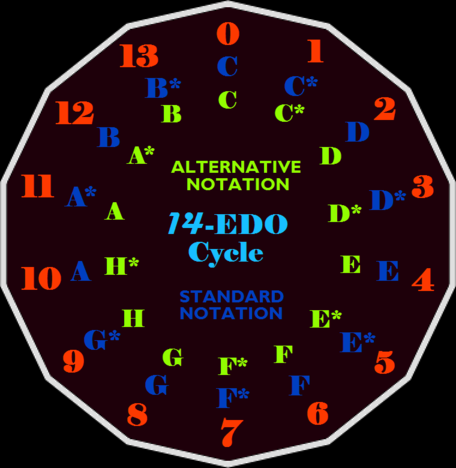
|
| Intervallic Cycle of 14 steps Equal per Octave |
Chord names
Ups and downs can be used to name 14edo chords. Because every interval is perfect, the quality can be omitted, and the words major, minor, augmented and diminished are never used. Alterations are always enclosed in parentheses, additions never are. An up or down immediately after the chord root affects the 3rd, 6th, 7th, and/or the 11th (every other note of a stacked-3rds chord 6-1-3-5-7-9-11-13).
0-4-8 = C E G = C = C or C perfect
0-3-8 = C vE G = Cv = C down
0-5-8 = C ^E G = C^ = C up
0-4-7 = C E vG = C(v5) = C down-five
0-5-9 = C ^E ^G = C^(^5) = C up up-five
0-4-8-12 = C E G B = C7 = C seven
0-4-8-11 = C E G vB = C,v7 = C add down-seven
0-3-8-12 = C vE G B = Cv,7 = C down add seven
0-3-8-11 = C vE G vB = Cv7 = C down-seven
For a more complete list, see Ups and Downs Notation #Chords and Chord Progressions.
JI approximation
Selected just intervals by error
Selected 13-limit intervals
Regular temperament properties
| Subgroup | Comma list | Mapping | Optimal 8ve stretch (¢) |
Tuning error | |
|---|---|---|---|---|---|
| Absolute (¢) | Relative (%) | ||||
| 2.3.7 | 49/48, 2187/2048 | [⟨14 22 39]] | +6.52 | 4.64 | 5.38 |
| 2.3.7.11 | 33/32, 49/48, 243/242 | [⟨14 22 39 48]] | +7.58 | 4.42 | 5.12 |
Uniform maps
Lua error in Module:Uniform_map at line 135: Must provide edo if not min or max given..
Rank-2 temperaments
Commas
14edo tempers out the following commas. This assumes the val ⟨14 22 33 39 48 52].
| Prime Limit |
Ratio[1] | Monzo | Cents | Color name | Name |
|---|---|---|---|---|---|
| 3 | 2187/2048 | [-11 7⟩ | 113.69 | Lawa | Apotome |
| 5 | 2048/2025 | [11 -4 -2⟩ | 19.55 | Sagugu | Diaschisma |
| 7 | 36/35 | [2 2 -1 -1⟩ | 48.77 | Rugu | Septimal quartertone |
| 7 | 49/48 | [-4 -1 0 2⟩ | 35.70 | Zozo | Slendro diesis |
| 7 | 1728/1715 | [6 3 -1 -3⟩ | 13.07 | Triru-agu | Orwellisma |
| 7 | 10976/10935 | [5 -7 -1 3⟩ | 6.48 | Satrizo-agu | Hemimage |
| 7 | (30 digits) | [47 -7 -7 -7⟩ | 0.34 | Trisa-seprugu | Akjaysma |
| 11 | 99/98 | [-1 2 0 -2 1⟩ | 17.58 | Loruru | Mothwellsma |
| 11 | 243/242 | [-1 5 0 0 -2⟩ | 7.14 | Lulu | Rastma |
| 11 | 385/384 | [-7 -1 1 1 1⟩ | 4.50 | Lozoyo | Keenanisma |
| 13 | 91/90 | [-1 -2 -1 1 0 1⟩ | 19.13 | Thozogu | Superleap |
| 13 | 676/675 | [2 -3 -2 0 0 2⟩ | 2.56 | Bithogu | Island comma |
- ↑ Ratios longer than 10 digits are presented by placeholders with informative hints
Scales
- 5 4 5 - MOS of 2L 1s
- 4 1 4 1 4 - MOS of 3L 2s
- 3 3 2 3 3 - MOS of 4L 1s
- 3 1 3 3 1 3 - MOS of 4L 2s
- 3 2 2 2 2 3 - MODMOS of 2L 4s
- 3 1 3 1 3 3 - MODMOS of 4L 2s
- 3 3 1 1 3 3 - MODMOS of 4L 2s; Antipental blues scale
- 2 2 2 2 1 4 1 - Fennec scale
- 2 2 1 2 2 2 1 2 - MOS of 6L 2s
- 2 1 2 2 2 2 1 2 - MODMOS of 6L 2s
- 2 1 2 1 2 1 2 1 2 - MOS of 5L 4s
- 1 2 1 2 1 1 2 1 2 1 - MOS of 4L 6s
- 1 2 1 1 1 2 1 1 1 2 1 - MOS of 3L 8s
- 1 1 2 1 1 1 1 1 2 1 1 1 MOS of 2L 10s
- 1 1 1 1 1 3 1 1 1 1 1 1 MOS of 1L 11s
- 1 1 1 1 1 1 2 1 1 1 1 1 1 MOS of 1L 12s
Here are the modes that create MOS scales in 14edo shown on horagrams from Scala, skipping multiples of 14:
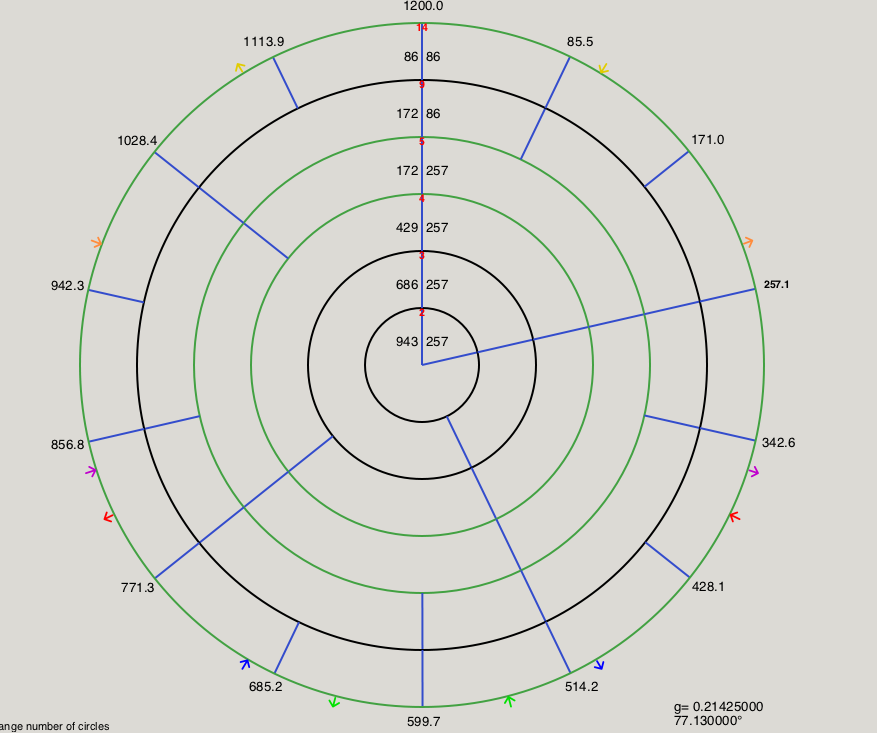
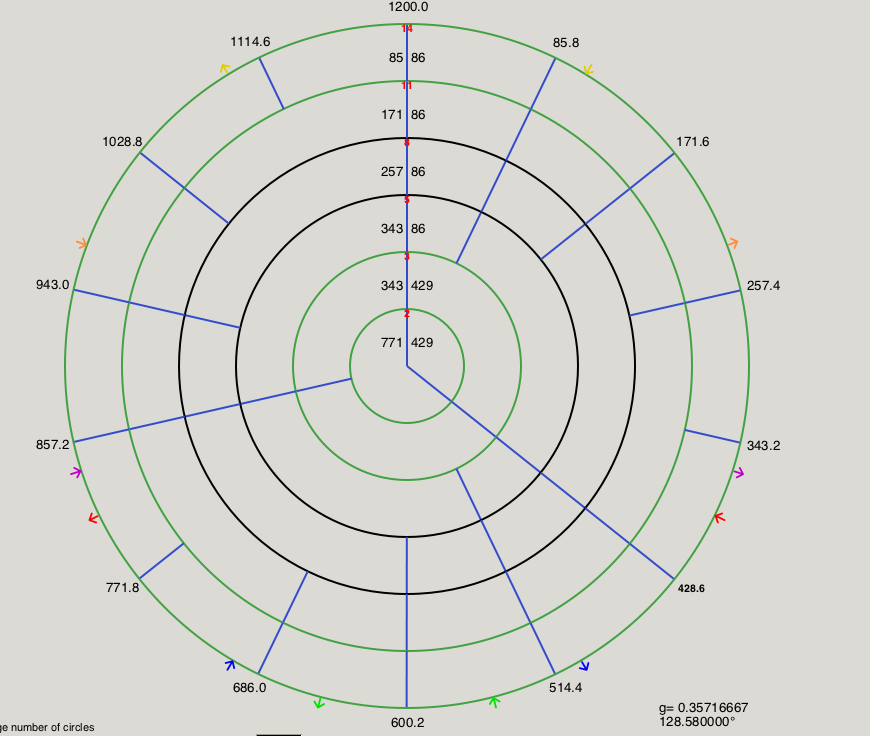
Titanium[9]
14edo is also the largest edo whose patent val supports titanium temperament, tempering out the chromatic semitone (21:20), and falling toward the "brittle" (fifths wider than in 9edo) end of that spectrum. Titanium is one of the simplest 7-limit temperaments, although rather inaccurate (the 7:5 is mapped onto 6\14, over 70 cents flat). Its otonal/major and utonal/minor tetrads are inversions of one another, which allows a greater variety of chord progressions (since different inversions of the same chord may have very different expressive qualities). Despite being so heavily tempered, the tetrads are still recognizable and aren't unpleasant-sounding as long as one uses the right timbres ("bell-like" or opaque-sounding ones probably work best). Titanium forms enneatonic modes which are melodically strong and are very similar to diatonic modes, only with two mediants and submediants instead of one. Titanium[9] has similarities to mavila, slendro, and pelog scales as well.
Using titanium[9], we could name the intervals of 14edo as follows. The 3, 5, 6, 8, 9, and 11-step intervals are all consonant, while 1, 2, 4, 7, 10, 12, and 13 steps are dissonant. There is no distinction between "perfect" (modulatory) and "imperfect" (major/minor) consonances here; there are enough chords here that root motion may occur by any consonant interval, and thus all six consonances are "perfect" intervals, rather than just two of them as in the diatonic system. As in the diatonic scale, the perfect intervals come in pairs separated by a major second, and with a characteristic dissonance between them; in titanium[9] there are three such pairs rather than just one.
- 1\14: Minor 2nd9: functions similarly to the diatonic minor second, but is more incisive.
- 2\14: Major 2nd9: functions similarly to the diatonic major second, but is narrower and has a rather different quality.
- 3\14: Perfect 3rd9: the generator, standing in for 8:7, 7:6, and 6:5, but closest to 7:6.
- 4\14: Augmented 3rd9, diminished 4th9: A dissonance, falling in between two perfect consonances and hence analogous to the tritone.
- 5\14: Perfect 4th9: technically represents 5:4 but is quite a bit wider.
- 6\14: Perfect 5th9: represents 4:3 and 7:5, much closer to the former.
- 7\14: Augmented 5th9, diminished 6th9: The so-called "tritone" (but no longer made up of three whole tones). Like 4\14 and 10\14, this is a characteristic dissonance separating a pair of perfect consonances.
- 8\14: Perfect 6th9: represents 10:7 and 3:2, much closer to the latter.
- 9\14: Perfect 7th9: technically represents 8:5 but noticeably narrower.
- 10\14: Augmented 7th9, diminished 8th9: The third and final characteristic dissonance, analogous to the tritone.
- 11\14: Perfect 8th9: Represents 5:3, 12:7 and 7:4.
- 12\14: Minor 9th9: Analogous to the diatonic minor seventh, but sharper than usual.
- 13\14: Major 9th9: A high, incisive leading tone.
- 14\14: The 10th9 or "enneatonic decave" (i. e. the octave, 2:1).
Diagrams
Software support
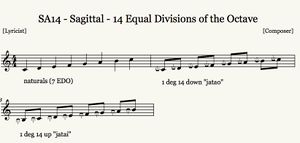
Music
- See also: Category:14edo tracks
- Feeling So Tired (2023)
- Warp Drive (2023)
- Autumn Aflame (2023)
- Cheap TVs From Overseas (2023)
- Pendula (for amplified trombone)
- "Detached and Distant", from Sean but not Heard (2012)
- "Sleep Deprived Cooked Alive", from Rhythm and Xen (2015)
- Ivor Darreg in Eagle Rock (score)
- "Chiral" from Micro Biological (2019) Spotify | Bandcamp | YouTube
- "Fires of The Frozen Jungle" from Nano Particular (2019) Spotify | Bandcamp | YouTube
- "Surprise Me" from Pico Metric (2019) Spotify | Bandcamp | YouTube
- "Orbital motive" from Lesser Groove (2020) Spotify | Bandcamp | YouTube
- "Jungle Tunnel" from Science Fraction (2022) Spotify | Bandcamp | YouTube
- Zvezda (2019)
- 14 TET 41441 (2020)
See also
Further reading
